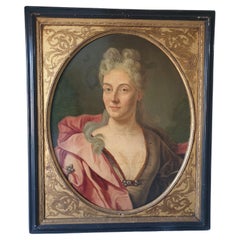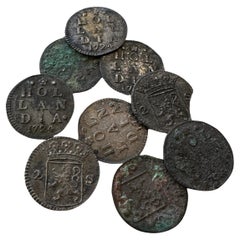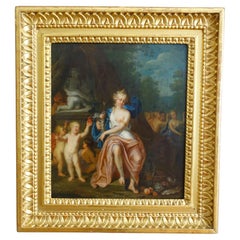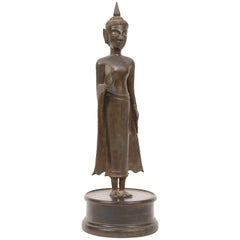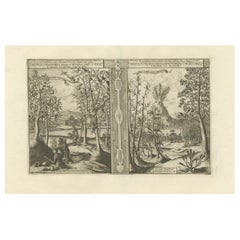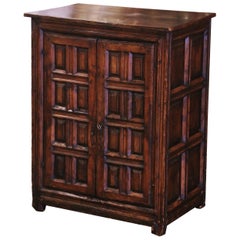Early 18th Century Furniture
to
742
1,784
873
2,769
345
261
97
47
40
28
16
14
11
6
6
3
3
1
1
40,561
134,843
550,795
285,565
85,769
261,109
125,529
12,808
5,641
18,697
22,907
19,648
54,178
72,465
61,139
21,618
9,222
1,234
605
562
376
273
1,930
498
454
404
364
2,769
2,769
2,769
66
34
10
5
5
Period: Early 18th Century
18th Century Oil On Canvas In Gilt Frame School Of Nicolas De Largilierre
By (circle of) Nicolas de Largillierre
Located in London, GB
School of Largillierre, Portrait of a Lady of the Verheyden Family. The original frame is black lacquered wood with gilt insert.
Nicolas de Largilliere (1656-1746), was born in Paris...
Category
French Rococo Antique Early 18th Century Furniture
Materials
Canvas
$1,321 Sale Price
20% Off
Dutch VOC Silver Shipwreck Treasure Coins From The Akerendam Shipwreck 1724
Located in AMSTERDAM, NH
Origin: Holland
Value: 2 pennies / 2 stuiver
Date: 1724
A VOC Akerendam shipwreck treasure of nine 2 stuivers minted by the Province of Holland ...
Category
Dutch Antique Early 18th Century Furniture
Materials
Silver
18th century Dutch school attributed to Mattheus Terwesten : allegory of wealth
Located in GRENOBLE, FR
A fine early 18th century Flemish school circa 1730, oil on panel attributed to Mattheus Terwesten (a partial signature next to the pedestal) set into its gold leaf gilt carved wood....
Category
Dutch Neoclassical Antique Early 18th Century Furniture
Materials
Oak
Standing Buddha Thailand, Ayuthaya Period, Early 18th Century
Located in Miami Beach, FL
This bronze standing Buddha mounted on a turned wood base has his right palm held outward in the abhaya mudra position, a gesture of fearlessness and reassurance.
Category
Thai Tribal Antique Early 18th Century Furniture
Materials
Bronze
$2,000 Sale Price
42% Off
Exotic Bounty: The Spice Lands of the East Indies by R. de Hooghe, circa 1708
Located in Langweer, NL
Exotic Bounty: The Spice Lands of the East Indies
The engraving depicts scenes from the East Indies, not the West Indies, which was a common point of confusion in historical texts d...
Category
Antique Early 18th Century Furniture
Materials
Paper
$632 Sale Price
20% Off
Early 18th Century Spanish Catalan Carved Walnut Two-Door Buffet Cabinet
Located in Dallas, TX
Hand-carved in northern Spain circa 1720, this exquisite antique cabinet showcases masterful craftsmanship and timeless elegance. Made from solid walnut, it features a rich, aged pat...
Category
Spanish Baroque Antique Early 18th Century Furniture
Materials
Iron
18th Century Carved Wooden Mater Dolorosa (Our Lady of Sorrows) Statue Sculpture
Located in London, GB
Mater Dolorosa Sculpture, Our Lady of Sorrows Sculpture, Religious Antique Sculpture, Church Antique Statue, Gothic Antique, Antique Mater Dolorosa,
...
Category
Austrian Baroque Antique Early 18th Century Furniture
Materials
Wood, Paint
Fine William And Mary Oyster Veneer Cabinet On Chest
Located in Bradenton, FL
A very fine quality late 17th century Oyster veneer cabinet on chest from the Queen Anne/William and Mary period with outstanding patina and nutty color, and of desirable proportions...
Category
English William and Mary Antique Early 18th Century Furniture
Materials
Olive
Antique German Baroque Inlaid Marquetry Dowry Chest Coffer Trunk Seat Bench 1700
Located in Portland, OR
A fine antique German Baroque inlaid marquetry walnut dowry chest coffer circa 1700.
The coffer having a lift up lid enclosing a storage space for clothing or linens, the chest is fi...
Category
German Baroque Antique Early 18th Century Furniture
Materials
Ebony, Fruitwood, Walnut
Early 18th Century Figured Walnut Bureau Cabinet
Located in Reepham, GB
A fine early Georgian walnut secretaire cabinet veneered throughout with book-matched figured walnut. The fall front opening to a fitted int...
Category
Antique Early 18th Century Furniture
Materials
Walnut
Pair Regence Fauteuils Armchairs Original Side Chairs Aubusson Tapestry Antique
Located in West Hollywood, CA
Pair Regence Fauteuils Armchairs Original Side Chairs Aubusson Tapestry Antique . Rare Pair of the 18th Century Regence Period ( French Regency ) Fauteuils Armchairs in Walnut with t...
Category
French Regency Antique Early 18th Century Furniture
Materials
Fabric, Wood, Walnut
$27,200 Sale Price / set
20% Off
Very large 1700's Aubusson Verdure Tapestry
Located in LYON, FR
Very large Aubusson Tapersty Circa 1720's.
‘Verdure’ (foliage) tapestries were woven throughout the 17th and 18th Centuries, featuring wooded landscapes, reflecting the interest in b...
Category
French Aubusson Antique Early 18th Century Furniture
Materials
Wool
18th Century Welsh Dresser
Located in Greenwich, CT
Fine 18th century English or welsh oak dresser, having richly molded crest over scalloped fascia, the divided shelves with plate grooves and standing on molded top over three drawers...
Category
Welsh Georgian Antique Early 18th Century Furniture
Materials
Oak
$14,900
Japanese Screen Pair, circa 1730, Peacocks and Phoenix, Kano School
Located in Kyoto, JP
Phoenix and Peacocks.
A pair of six-panel Japanese folding screens by Tsunetake Yotei (n.d.)
First half of the 18th century.
The signature reads 67 year old Tsunetake.
The seals read:
-Tsunetake no in,
-Yotei,
-Seishin
Dimensions:
Each screen – H. 69” x W. 149” (176 cm x 378 cm)
A pair of Kano Grand Picture (Waga) screens depicting phoenix and peacocks rich with symbolic meaning. Dating to the first half of the 18th century, from the Kobikicho Kano school in Edo, this pair of folding...
Category
Asian Edo Antique Early 18th Century Furniture
Materials
Gold Leaf
Tall Early 18th C. Italian Wooden Storage & Display Cabinet, a Fabulous Piece
Located in Atlanta, GA
A tall Italian wooden storage and display cabinet from the early 18th century. This antique cabinet from Italy, which stands approximately 6.75 feet tall, has a flat top and upper section is fitted with a pair of wooden doors with spindle tops over lattice at door fronts, which open to reveal three shelves for displayed objects inside. Upon closer inspection, you will find that the wood framing and hardware is decorated with hand-punched floral carvings throughout. The mid-section has a pair of solid-wood doors...
Category
Italian Antique Early 18th Century Furniture
Materials
Wood
Cellarius Andreas Pair of Celestial Maps 18th Century from Harmonia Macrocosmica
By Andreas Cellarius
Located in Milano, MI
Cellarius Andreas Pair of 18th Century Watercolor Celestial Maps within gilt frames, titled
Planisphaerivm Aratevm sive Compages Orbivm Mvndanorvm ex Hypothesi Aratea in Plano Expre...
Category
Dutch Renaissance Antique Early 18th Century Furniture
Materials
Paper, Giltwood
18th Century Spain Manises Valencia Ceramic Plate Lustre-Painted Decoration
Located in Epfach, DE
Beautiful ceramic plate from Valencia made in the early 18th century. The ceramic has been glazed with a glossy painted bird depiction. The bird depictions are very rare and hard to find. The ceramic is glazed in an enamel bath...
Category
Spanish Antique Early 18th Century Furniture
Materials
Ceramic
Set of Chinese Blue and White Plate for Wall Decoration Porcelain China
Located in Amsterdam, Noord Holland
Perfect for interior wall decoration. We offer sets of 18th century Chinese blue and white plates. Available in every quantity needed. The selection in the pictures might not be avai...
Category
Chinese Qing Antique Early 18th Century Furniture
Materials
Porcelain
$2,155 Sale Price / set
20% Off
Early 18th Century Large Pair of Wood Carved French Baroque Solomonic Columns
Located in Vero Beach, FL
Early 18th Century Large Pair of Wood Carved French Baroque Solomonic Columns
These beautiful and rare carvings are polychrome and gilded. The columns are graduated. Decorative ca...
Category
French Baroque Antique Early 18th Century Furniture
Materials
Wood
$3,937 Sale Price / set
25% Off
18th Century, Painting with Still Life by Maximilian Pfeiler
Located in IT
Maximilian Pfeiler (active Rome, circa 1694-circa 1721 Budapest)
Still life with peaches, grapes, figs and pomegranate
Oil on canvas, Measures: cm H 63,5 x W 47. With frame cm ...
Category
Italian Baroque Antique Early 18th Century Furniture
Materials
Canvas, Wood
18th Century Louis XIV Period Lyonnaise Chateau Bonnetiere
Located in Birmingham, AL
Rare and difficult to find Louis XIV period chateau bonnetiere. Solid walnut. An exceptional example from the Lyon region of France, renown in the 1700s for its superior production o...
Category
French Louis XIV Antique Early 18th Century Furniture
Materials
Walnut
French Régence Biblioteque, Early 18th Century
Located in Doylestown, PA
A rare French Régence period biblioteque, circa 1740, with arched wire-inset doors over two lower square paneled doors with adjustable interior shelves, “galbe” paneled side doors co...
Category
French Régence Antique Early 18th Century Furniture
Materials
Wood
$8,500 Sale Price
48% Off
18th Century, Italian Inlaid Wood Chest of Drawers with Secretaire
Located in IT
18th century, Italian inlaid wood chest of drawers with secretaire
This chest of drawers with secretaire represents the elegant pr...
Category
Italian Baroque Antique Early 18th Century Furniture
Materials
Wood
$34,494 Sale Price
20% Off
Huge early 1700's Verdure Aubusson Tapestry
Located in LYON, FR
French Aubusson woven tapestry from the early 1700's depicting a lizard standing in luscious vegetation. Created in Aubusson, located in central France. Interestingly this vertical w...
Category
French Aubusson Antique Early 18th Century Furniture
Materials
Wool, Silk
18th Century Antique Dutch Renaissance Rustic Natural Oak 'Bolpoot Tafel' Table
Located in Casteren, NL
Beautiful and authentic Dutch Renaissance table made in solid European Summer oak. The top was made in three wide boards of oak and has a fantastic grain pattern and a weathered surf...
Category
Dutch Renaissance Antique Early 18th Century Furniture
Materials
Oak
Chinese porcelain wucai vase, Kangxi period
Located in New York, NY
4.5in(D) x 4.5in(W) x 8.5in(H) are the dimensions of the vase only (not including the wooden base); the wooden base shown in the pictures is included with this item; vase is decorate...
Category
Chinese Antique Early 18th Century Furniture
Materials
Porcelain
Antique Engraving of the Brass Laver in Solomon's Temple, Jerusalem, ca.1725
Located in Langweer, NL
Antique religion print titled 'Het kopere Waschvat, Tusschen de Tente der t'zamenkomst en den altaar'.
Antique print of the Brass Laver in Solomon's Tem...
Category
Antique Early 18th Century Furniture
Materials
Paper
$229 Sale Price
20% Off
Swedish Candle Wall Sconce, Early 18th Century with Småland's Landscape Arms
Located in Knivsta, SE
A rare Swedish candle wall sconce from early 18th century with Småland´s landscape arms. Made in brass and with a beautiful patina.
Wear consistent ...
Category
Swedish Baroque Antique Early 18th Century Furniture
Materials
Brass
Early 18th Century English Low Dresser
Located in Greenwich, CT
Good English oak low dresser, having molded top over three drawers over scalloped apron and standing on bold turned legs ending in original bal...
Category
English Queen Anne Antique Early 18th Century Furniture
Materials
Oak
Blue and White Garden Pattern Tea Set c 1725, Qing Dynasty, Yongzheng Reign
Located in seoul, KR
The saucer set depicts botanical garden, motifs rich in symbolism within east asian culture. Each teabowl depicts scenes, characters and situations are richly depicted inside the sma...
Category
Vietnamese Chinoiserie Antique Early 18th Century Furniture
Materials
Ceramic, Porcelain
Early 18th Century Regence Cupboard Armoire Buffet
Located in Vosselaar, BE
A great early 18th century French oak two-door armoire with a buffet interior. The exterior beautifully sculpted and the interior with blue paint.
Category
French Louis XIV Antique Early 18th Century Furniture
Materials
Oak
A beautiful Celestial Table Globe produced by Gerard & Leonard Valk
Located in ZWIJNDRECHT, NL
A magnificent and very rare early 18th century celestial table globe produced by Gerard and Leonard Valk. Established at the end of the previous ...
Category
Dutch Dutch Colonial Antique Early 18th Century Furniture
Materials
Other
$192,157 Sale Price
20% Off
French Early 18th Century Sofa
Located in Stockbridge, GA
French early 18th century sofa.
Category
French Regency Antique Early 18th Century Furniture
Materials
Walnut
English Gate-leg Table Folding in Oak Wood - 18th Century - England
Located in Beuzevillette, FR
Large 18th century English round table called "gate leg". This type of table with removable flaps has pivoting feet to support the flaps when it is...
Category
English Antique Early 18th Century Furniture
Materials
Wood
Small French Bronze Mortar and Pestle with Fleur De Lys and Crown, Circa 1700
Located in Dallas, TX
This small bronze mortar and pestle are from France, circa 1700. The circular opening has several layers of molding, with the bottom three interrupted by a pair of open crowns on opp...
Category
French Louis XIV Antique Early 18th Century Furniture
Materials
Bronze
Elegant French Louis XV Period Secretary Writing Desk with Hidden Compartment
Located in Atlanta, GA
A French Louis XV period Rococo secretary with hidden compartment, circa 1760. This antique French writing desk features a slant-leaf front...
Category
French Louis XV Antique Early 18th Century Furniture
Materials
Wood
Chinese Export Kangxi Period Teapot Hand Painted Imari Pattern, Circa 1710
Located in Lincoln, Lincolnshire
This is a very good early Chinese Teapot and matching cover from the Qing Dynasty, Kangxi period ( 1662 to 1722) which we date to Circa 1710.
The teapot has a globular form on a sho...
Category
Chinese Chinese Export Antique Early 18th Century Furniture
Materials
Porcelain
$820 Sale Price
65% Off
Triptych Russian Icon of Christ & The Virgin of the Unfading Roses, c. 1700's
Located in Los Angeles, CA
A traditional Russian triptych of Christ and the Virgin of the Unfading Roses. The Mother of God and her son are shown wearing crowns and dressed in r...
Category
Russian Antique Early 18th Century Furniture
Materials
Wood, Paint
Early 18th Century oak side table
Located in Martlesham, GB
An early 18th Century oak side table, having a nice figured rectangular top above a single oak lined frieze drawer with brass petal shaped drop handles and escutcheon, raised on turn...
Category
British Queen Anne Antique Early 18th Century Furniture
Materials
Oak
Early Irish Rectangular Hunt Table with Drop-Leaf and Butted Gate Fold Legs
Located in Louisville, KY
This very early Irish Hunt Table is a rare and unique piece of history. Unlike many European hunt tables, this one is a smaller, more primitive rectangular table constructed with fun...
Category
Northern Irish Georgian Antique Early 18th Century Furniture
Materials
Iron
Chinese Porcelain Famille Verte Large "Flower Basket" Dish, Kangxi Period
Located in Downingtown, PA
Chinese porcelain Famille Verte large "flower basket" dish,
Kangxi Period
The Chinese Export porcelain large dish is painted in “famille verte” enamels with a central medallion o...
Category
Chinese Chinese Export Antique Early 18th Century Furniture
Materials
Porcelain
Large Scale Period Louis XIV Boulle Cartel Clock with Matching Plinth/Bracket
Located in Vancouver, British Columbia
Grand scale boulle Cartel clock and matching plinth, the ebonized wood case is embellished all-over with gilded bronze mounts (re-gilt). The medall...
Category
French Louis XIV Antique Early 18th Century Furniture
Materials
Brass, Bronze
$12,000 Sale Price
47% Off
18th Century, Italian Pair of Oil on Canvas Paintings by Francesco Simonini
By SIMONINI
Located in IT
Francesco Simonini (Parma, 16 June 1686 - Parma, 1766)
“The rest of the soldiers” and “The march of soldiers”
oil on canvas
cm 40 x 58 and 40 x 60 ; frame: h 52,5 x W 70,5 x D 6 an...
Category
Italian Baroque Antique Early 18th Century Furniture
Materials
Canvas
$28,027 Sale Price
35% Off
19th Century Giltwood and Gesso Catholic Processional Crown
Located in Hastings, GB
A beautiful and very rare early 19th century Catholic processional Crown, hand crafted in wood with applied gesso and gilt, with rich, dark jewel adornments, (some missing) in wonder...
Category
German Baroque Antique Early 18th Century Furniture
Materials
Gesso, Wood
William And Mary Oyster Burl Walnut Chest Of Drawers
Located in Bradenton, FL
William and Mary oyster veneer Chest of Drawers, late 17th/early 18thc. Great Burl decorated veneer rectangular top wit...
Category
English William and Mary Antique Early 18th Century Furniture
Materials
Burl
18th century George I walnut cabinet on chest
Located in Debenham, Suffolk
18th century George I walnut cabinet on chest circa 1710.
We are pleased to offer this stunning cabinet in the manner of Coxed and Woster.
The piece is lavishly veneered in burr wa...
Category
English George I Antique Early 18th Century Furniture
Materials
Walnut
Flemish Tapestry Three Panel Screen
Located in Essex, MA
Three tapestry fragments mounted in a late 19c carved walnut frame.
Category
French Baroque Antique Early 18th Century Furniture
Materials
Tapestry, Walnut
Spode Pottery Neoclassical Greek Pattern Blue Printed Supper Set
By Spode
Located in Downingtown, PA
Spode pottery neoclassical Greek pattern blue printed supper set
Early-19th century
From a large collection of Greek pattern pieces in various colors ...
Category
English Neoclassical Antique Early 18th Century Furniture
Materials
Pearlware, Pottery
Dutch Delft Dish Pancake Plate Lightning Pattern De Paeuw 'The Peacock' C-1730
By De Paeuw
Located in Katonah, NY
This extraordinary Dutch Delft pancake plate was made in the early 18th century.
Beautifully hand-painted, it features bold zigzag lighting bolts, Bliksemborden, which seem to flash across the plate.
Between the lightning bolts, we see clouds painted...
Category
Dutch Chinoiserie Antique Early 18th Century Furniture
Materials
Delft
Antique Chinese Qing Dynasty Canton Porcelain Famille Rose Qianlong Tureen 18 Ct
Located in Dublin, Ireland
An Imposing Hand Painted Chinese Export Porcelain Twin Handle Enameled Soup Tureen or Centerpiece of large proportions and traditional form, made during last quarter of the Eighteent...
Category
Chinese Chinese Export Antique Early 18th Century Furniture
Materials
Porcelain
GENUINE Renaissance Walnut Cabinet Buffet, Italian, Early 17TH Century
Located in San Francisco, CA
A tall walnut cabinet buffet, having a plank top with dentil moulding above a single drawer. The recessed paneled doors with iron pulls, flanked by Doric columns sitting on multi-moi...
Category
Italian Renaissance Antique Early 18th Century Furniture
Materials
Walnut
MAGNIFICENT AND RARE EUROPEAN CRADLE 18th Century
Located in Madrid, ES
MAGNIFICENT AND RARE EUROPEAN CRADLE 18th Century
in painted and gilded wood with scrolls, puttis and profuse floral decoration.
Small defects.
Dim.: 68 x 94 x 43 cm
good conditions
Category
European Baroque Antique Early 18th Century Furniture
Materials
Wood
A Pair of Elegant Empire Candlesticks, Gilded and Patinated Brass, 1820s France
Located in Knivsta, SE
A pair of exquisite Empire candlesticks which combine gilt and patinated brass. Made in 1820s France. Various intricate rose, floral and leaf patterns adorn the bases in gilt brass. ...
Category
French Empire Antique Early 18th Century Furniture
Materials
Brass
Antique Queen Anne Early 18th Century Inlaid Burr Walnut Escritoire Desk Chest
Located in Wisbech, Cambridgeshire
Antique Early 18th Century Queen Anne Inlaid Burr Walnut Escritoire/Desk/Chest
This fine quality early 18th Century Queen Anne escritoire is a wonderfully charming period piece, sho...
Category
Queen Anne Antique Early 18th Century Furniture
Materials
Walnut
$5,776 Sale Price
30% Off
An early 18th century Florentine Ebonized Wood Aedicule Case
Located in Leesburg, VA
An early 18th century Florentine ebonized wood aedicule case with gilt metal embellishments
Ambit of Leonard van der Vinne
Possibly first decade of the 18th century; Florence, Italy
Approximate size: 83.5 (h) x 69 (w) x 23 (d) cm
The cabinet’s centralized glass door is flanked by thick spiraling Solomonic columns surmounting a lower drawer. To the rear of the cabinet, the motif repeats in an eloquent display of perspectival treatment. The overall work is supported by a tiered base, elegantly conceived, and the cabinet is topped by a handsome pediment flanked by square plinths crested by gilt metal finials and an openwork frieze.
The cabinet’s tempered and moderate form suggests an origin probably during the first decade or quarter of the 18th century. Although utilitarian in concept, the reserved and sublime expressiveness of this cabinet is managed with a quality and care respective of the influence of Florentine ebony cabinetry work conceived in the Galleria dei lavori or Grand Ducal Workshops of the 18th century Medici dynasty. In particular, its base mouldings echo a remarkable Night Clock...
Category
Italian Baroque Antique Early 18th Century Furniture
Materials
Brass
Early 18th Century Italian Walnut Low Two Drawer Chest / Bench
Located in San Francisco, CA
A walnut, burl walnut and pine two drawer chest with inlay detail. This was originally a taller four drawer chest. It was most likely cut down to its current height in the early 20th...
Category
Italian Antique Early 18th Century Furniture
Materials
Walnut
$1,960 Sale Price
20% Off
Bed Tester Spanish Baroque Carved Dark Green & Gilded Leather Superking 6ft180cm
Located in BUNGAY, SUFFOLK
Rare, Spanish Demi-Tester, Baroque Bed With Carved, Green Painted & Gilded Posts 181cm, 6ft High, Floral Painted Leather Headboard, sold with custom made box spring mattress base, ac...
Category
Spanish Baroque Antique Early 18th Century Furniture
Materials
Giltwood, Paint
1720 Etching of St. Christopher's Cathedral in Roermond by Jacobus Harrewijn
Located in Langweer, NL
This antique print, titled *L'Eglise Cathedrale de S. Christophre à Ruremonde*, is an etching and engraving created by Jacobus Harrewijn around 1720.
It offers a detailed view of S...
Category
Antique Early 18th Century Furniture
Materials
Paper
$124 Sale Price
20% Off
18th Century Swedish Baroque Cupboard Sideboard
Located in Haddonfield, NJ
A period style Baroque early 18th Century baroque cupboard in dark patinated pine wood. The clean and useful interior is of a later date and features two drawers that can be used for...
Category
Swedish Baroque Antique Early 18th Century Furniture
Materials
Pine
Original 18th Century Venetian Secretary Desk Bookcase burled walnut with inlaid
Located in Vigonza, Padua
What makes this piece unique and special is its originali twist to the characteristic Secretaire, a must-have object among Venetian aristocratic families that could not be missing in...
Category
Italian Baroque Antique Early 18th Century Furniture
Materials
Walnut
